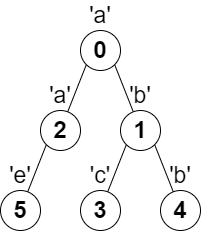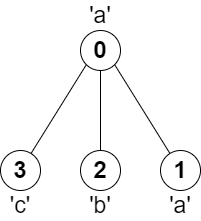| comments | difficulty | edit_url | rating | source | tags | ||||||
|---|---|---|---|---|---|---|---|---|---|---|---|
true |
Hard |
2126 |
Weekly Contest 289 Q4 |
|
You are given a tree (i.e. a connected, undirected graph that has no cycles) rooted at node 0 consisting of n nodes numbered from 0 to n - 1. The tree is represented by a 0-indexed array parent of size n, where parent[i] is the parent of node i. Since node 0 is the root, parent[0] == -1.
You are also given a string s of length n, where s[i] is the character assigned to node i.
Return the length of the longest path in the tree such that no pair of adjacent nodes on the path have the same character assigned to them.
Example 1:
Input: parent = [-1,0,0,1,1,2], s = "abacbe" Output: 3 Explanation: The longest path where each two adjacent nodes have different characters in the tree is the path: 0 -> 1 -> 3. The length of this path is 3, so 3 is returned. It can be proven that there is no longer path that satisfies the conditions.
Example 2:
Input: parent = [-1,0,0,0], s = "aabc" Output: 3 Explanation: The longest path where each two adjacent nodes have different characters is the path: 2 -> 0 -> 3. The length of this path is 3, so 3 is returned.
Constraints:
n == parent.length == s.length1 <= n <= 1050 <= parent[i] <= n - 1for alli >= 1parent[0] == -1parentrepresents a valid tree.sconsists of only lowercase English letters.
First, we construct an adjacency list
Then we start DFS from the root node. For each node
Finally, we return
The time complexity is
class Solution:
def longestPath(self, parent: List[int], s: str) -> int:
def dfs(i: int) -> int:
mx = 0
nonlocal ans
for j in g[i]:
x = dfs(j) + 1
if s[i] != s[j]:
ans = max(ans, mx + x)
mx = max(mx, x)
return mx
g = defaultdict(list)
for i in range(1, len(parent)):
g[parent[i]].append(i)
ans = 0
dfs(0)
return ans + 1class Solution {
private List<Integer>[] g;
private String s;
private int ans;
public int longestPath(int[] parent, String s) {
int n = parent.length;
g = new List[n];
this.s = s;
Arrays.setAll(g, k -> new ArrayList<>());
for (int i = 1; i < n; ++i) {
g[parent[i]].add(i);
}
dfs(0);
return ans + 1;
}
private int dfs(int i) {
int mx = 0;
for (int j : g[i]) {
int x = dfs(j) + 1;
if (s.charAt(i) != s.charAt(j)) {
ans = Math.max(ans, mx + x);
mx = Math.max(mx, x);
}
}
return mx;
}
}class Solution {
public:
int longestPath(vector<int>& parent, string s) {
int n = parent.size();
vector<int> g[n];
for (int i = 1; i < n; ++i) {
g[parent[i]].push_back(i);
}
int ans = 0;
function<int(int)> dfs = [&](int i) -> int {
int mx = 0;
for (int j : g[i]) {
int x = dfs(j) + 1;
if (s[i] != s[j]) {
ans = max(ans, mx + x);
mx = max(mx, x);
}
}
return mx;
};
dfs(0);
return ans + 1;
}
};func longestPath(parent []int, s string) int {
n := len(parent)
g := make([][]int, n)
for i := 1; i < n; i++ {
g[parent[i]] = append(g[parent[i]], i)
}
ans := 0
var dfs func(int) int
dfs = func(i int) int {
mx := 0
for _, j := range g[i] {
x := dfs(j) + 1
if s[i] != s[j] {
ans = max(ans, x+mx)
mx = max(mx, x)
}
}
return mx
}
dfs(0)
return ans + 1
}function longestPath(parent: number[], s: string): number {
const n = parent.length;
const g: number[][] = Array.from({ length: n }, () => []);
for (let i = 1; i < n; ++i) {
g[parent[i]].push(i);
}
let ans = 0;
const dfs = (i: number): number => {
let mx = 0;
for (const j of g[i]) {
const x = dfs(j) + 1;
if (s[i] !== s[j]) {
ans = Math.max(ans, mx + x);
mx = Math.max(mx, x);
}
}
return mx;
};
dfs(0);
return ans + 1;
}
